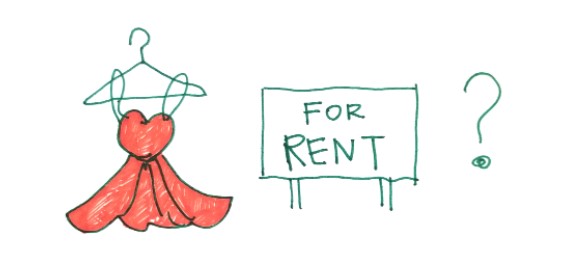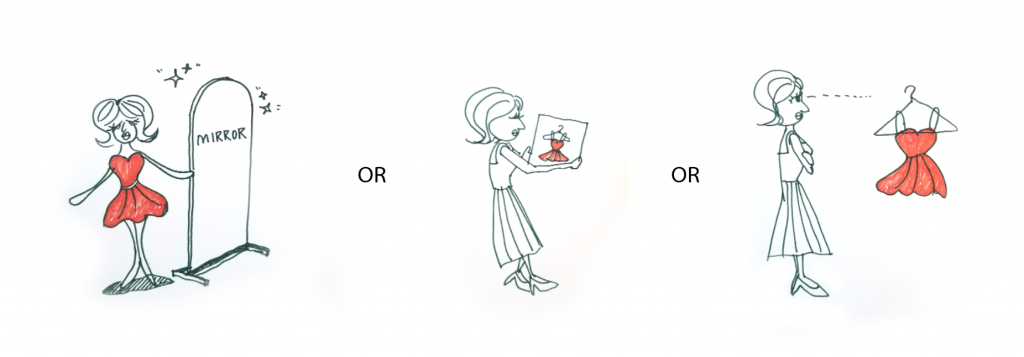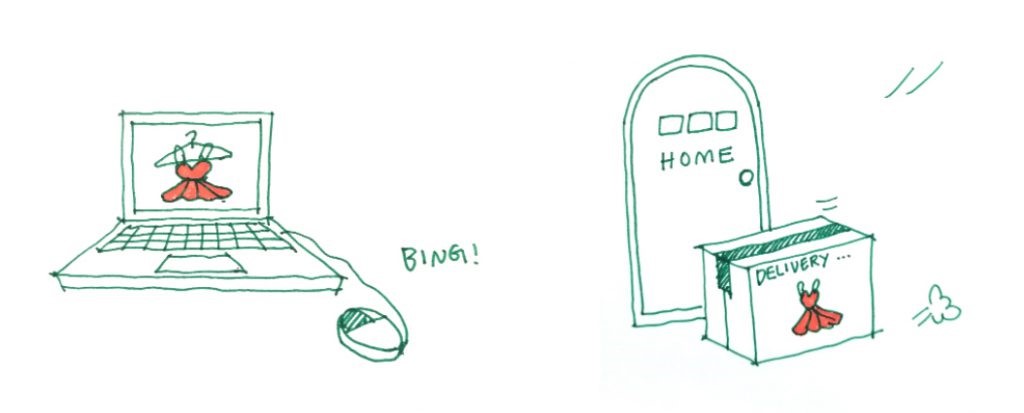Proof of Concept / Prototype / Minimum Lovable Product Fashionably Explained

All new products or services start with an idea whether you are an established enterprise or a startup. Your idea could be so new that nothing like it exists. It could be brilliant. Or totally insane. So how do you know if you should proceed? Creating a proof of concept, prototype, or minimum lovable product (MLP) can help you get started. These methods allow you to quickly learn as much as possible and help you determine whether to pivot or persevere with the idea.
However, these methods are frequently confused. In this post, I discuss the proof of concept, prototype, and MLP using one of my favorite services, “Rent the Runway,” as an example. The order of methods in not written sequentially and can be easily rearranged and combined to fit the goals of your idea.
Rent the Runway
If you are not familiar with Rent the Runway: In 2009 two Harvard Business School classmates, Jenn Hyman and Jenny Fleiss, had an idea that would capitalize on the shift to experience and sharing economies by launching a dress rental business allowing women to rent designer gowns for a fraction of the retail cost to look glamourous for special occasions.
Over the course of eight years the business grew its user base to +6 million customers generating more than $100 million in annual revenue. The offering has expanded beyond formal gowns to a membership service that includes everyday wear. This successful business didn’t unfold overnight. Starting out, Jenn and Jenny knew very little about the fashion and technology industries and had to go through strategic experimentation and learning iterations to get to where the business is today.
Let’s discuss the methods they used to aid in the experimentation and expedite the learning that helped them launch such a lovable service. The following sections explain the key differences across the proof of concept, prototype, and MLP methods and what you should expect to achieve with each based on the maturity of your idea.
Rent the Runway Proof of Concept
A proof of concept is a very quick method of testing to determine whether an idea is feasible: “is this possible?”
If your idea has never been done before and there is no comparable market data, a proof of concept can help validate whether the idea is possible. A proof of concept is not meant to be scalable. Its purpose is to demonstrate if a certain portion of a product or functionally can be done. Coming out of the proof of concept phase, the team should have a better understanding of whether the idea has potential or should be abandoned.
Now let’s look at Rent the Runway through the lens of a proof of concept. Initially Jenn and Jenny pitched their clothing rental idea to designer Diane von Furstenberg. But without an actual product or user data to support their idea, Diane didn’t have much of an appetite in participating. As shared on the “How I Built This with Guy Raz” Podcast, Jenn and Jenny took a leap of faith by dipping into their savings to purchase 100 gowns from Bloomingdales and hosting a pop-up rental shop at Harvard University over a weekend. This pop-up rental shop served as their proof of concept. Over the course of the weekend, the Rent the Runway founders were looking to learn:
- Are women interested in renting dresses?
- What types of dresses would they rent?
- How much would they pay for the service?
- What should happen after the rental?

They observed the proof of concept participants and noticed the sheer delight the students got from trying a new dress that made them feel beautiful. From the pop-up shop proof of concept experience, Jenn and Jenny knew they were on to something.
Exit criteria: You gathered enough data from the proof of concept to answer key questions on whether an idea has practical potential and should be attempted.
Rent the Runway Prototype
A prototype is an actual representation of an idea that you can test and obtain feedback, allowing you to gauge the reactions you’d get when your idea is put into action. An interactive prototype is a crafty approach for wowing investors or stakeholders.
A prototype is a vehicle for feedback testing out your idea by communicating the initial design and navigating the user through the experience to validate assumptions based on the end user’s critical needs. As we’ve previously written on our blog, the prototype can range from low to high fidelity depending on the assumptions for validation. It’s a good idea to expose your potential customers to the prototype in order to observe how they would interact with the product.
Now let’s see how a prototype applied to Rent the Runway. After establishing that their idea had potential via the proof of concept, the founders experimented with a series of prototypes to confirm that they were solving for a real problem in the most lovable way before creating the first version of the Rent the Runway website. Jenn and Jenny prototyped a variation of their proof of concept by taking the same 100 dresses to Yale’s campus. In this prototype of the rental experience, the students were not able to try the dresses on prior to renting. The next prototype involved sending photos of the dresses in the form of PDF documents to observe if and what dresses the students would rent by only seeing a paper representation of the garment. Each prototype informed what product description information should be captured to help customers select the “perfect dress”, leading the founders closer to the creation of the dress rental website.

The series of prototypes also provided a great opportunity to prove to investors (who were men and did not understand the emotional connection women have with fashion) the immense opportunity of this idea by being able to witness customers’ reactions.
Exit criteria: You captured customer feedback and observed reactions to validate assumptions and discover learnings to build a lovable product/service.
Rent the Runway Minimum Lovable Product (MLP)
The minimum lovable product (MLP) is a simple end-to-end version of a new product/service. The MLP allows you to collect validated learnings from customers at a minimal cost, ideally resulting in your product receiving maximum amount of love. The minimum viable product (MVP) is also a commonly used method for launching products faster to gather customer feedback. But the MVP prioritizes delivering with the least amount of effort and expense, while the MLP involves the customers and stresses on delivering the most customer love with the least amount of effort and expense. As we have written on our blog, the MLP engages customers from the start throughout concepting and design stages and as a result the product is more customer focused.
When starting a business that is heavily customer centric delivering a lovable customer experience is key for success. The Rent the Runway founders had to ensure their first “tribe” of customers had a great experience during the launch of their MLP.
Back in 2009, the idea of everyday clothes rental service was considered disruptive and may not have appealed to the masses. Jenn and Jenny decided to slowly introduce the idea by focusing on the more common use cases such as special occasion wear. The Rent the Runway MLP was a website strictly offering a gown rental service. It focused on the lovable aspects of the service such as providing customers with two sizes to guarantee fit. As they learned from their customer behavior and the sharing economy evolved in other industries, Rent the Runway started transitioning to the bigger idea of having your “closet in the cloud” — moving from owning clothes to renting and wearing every day. Today they have several stores throughout the United States and own the world’s biggest dry cleaning service.

Exit criteria: You defined a lovable experience to gain insights from your customers. With the new learnings, you can continue iterating on the product/service by applying the insights to expand the MLP and beyond.
Beyond the MLP
Once Rent the Runway was an established lovable service, they continued to expand their business by learning from the build – learn – measure loop as they iterated on the MLP. They added new capabilities to maintain their competitive advantage and deliver more lovable experiences to their customers. Some examples of these capabilities include:
- Robust analytics to learn about customers’ style preferences and recommend fit.
- Streamlined shipping and fulfilling process to provide a faster delivery service.
- Partnerships with designers to inform customers’ preferences and influence fashion trends.
How to Get Started
So how do you get started with your idea? Since all three methods provide different objectives, they can be combined to attain the desired learnings. You should focus on determining what you need to achieve at the stage your idea is at and what you need to learn to take your idea to the next level.
Before selecting to build a proof of concept, prototype, or MLP, what you really need to do is ask yourself the following questions:
What am I trying to validate?
Is my idea feasible in the market? Can it be done?
> PROOF OF CONCEPT
Do I need to learn and get feedback to validate my assumptions and discover new learnings?
> PROTOTYPE
Is my idea viable? Can it be sustained while offering a lovable experience?
> MLP
Who am I targeting with the selected method?
Identify the right customers to test with for your Proof of Concept, Prototype, and MLP
Use the Right Tools
At Moonshot, we help businesses launch innovative products at scale in a way that minimizes risk and cost. Our FUEL methodology allows our clients to test innovative ideas and turn those ideas into products/services while optimizing time and resources. We use tools such as design sprints and decision dashes to help businesses develop and validate their ideas with the customer at the center. If your idea is currently mired in ambiguity, Contact Moonshot to gain clarity. We’d love to help.
